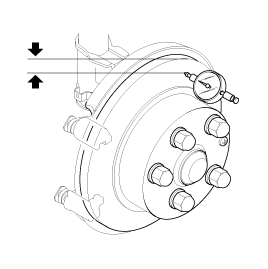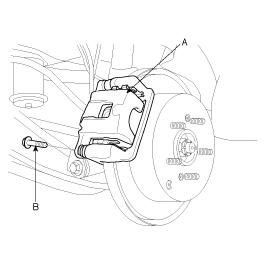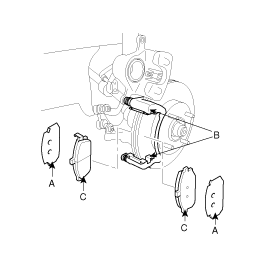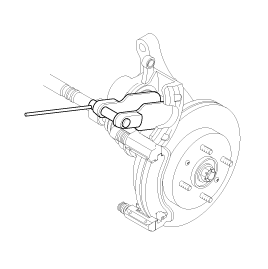Check the pad wear. Measure the pad thickness and replace it, if it is less than the specified value.
Pad thickness
Standard value : 10.0 mm ( 0.39in.)
Service limit : 2.0 mm (0.0787 in.)

Remove all rust and contamination from the disc surface, and then measure the disc thickness at 8 points, at least,of the same distance (5mm) from the brake disk outer circle.
Rear brake disc thickness
Standard value : 10.0 mm ( 0.39 in.)
Limit : 8.0 mm (0.315 in.)
Thickness variation should not exceed 0.005mm(0.0002 in.) (circumference) and 0.01mm(0.0020 in.) (radius) at any directions.
If wear exceeds the limit, replace the discs and pad assembly for left and right of the vehicle.

Check the pad wear. Measure the pad thickness and replace it, if it is less than the specified value.
Pad thickness
Standard value : 10.0 mm ( 0.39in.)
Service limit : 2.0 mm (0.0787 in.)

Check that grease is applied, and the pad and backing metal for damage.
Place a dial gauge about 5mm (0.2 in.) from the outer circumference of the brake disc, and measure the run out of the disc.
Brake disc run out
Limit : 0.03 mm (0.0012 in.) or less

If the run out of the brake disc exceeds the limit specification, replace the disc, and then measure the run out again.
If the run out does not exceed the limit specification, install the brake disc after turning it 180° and then check the run out of the brake disc again.
If the run out cannot be corrected by changing the position of the brake disc, replace the brake disc.
Raise the rear of the vehicle and make sure it is securely supported. Remove the rear wheel.
Release the parking brake.
Remove the two guide rod bolt (B) and support the caliper assembly with a piece of wire so that it does not hang from the brake hose.

Remove the pad shims (A), pad retainers(B), and pads (C).

Install the pad springs(A) to the carrier(B).

Check the foreign material at the pad shim (A) and the back of the pads (B).

Contaminated brake discs or pads reduce stopping ability. Keep grease off the discs and pads.
Insert the piston in the cylinder using the special tool(09581-11000).


Install the brake pads (B) and pad shim (A) on the capliper braket.
Install the inner pad with its wear indicator (C) facing down ward.
If you are reusing the pads, always reinstall the brake pads in their original positions to prevent a momtary loss of braking efficiency.
Rotate the caliper piston (A) clockwise into the cylinder, the align the cutout (B) in the piston with the tab (C) on the inner pad by turning the piston back.
Lubricate the boot with rubber grease to avoid twisting the piston boot.
If the piston boot is twisted, back it out so it is positioned properly.
Install the brake caliper (D).
Install and torque the guide rods (E) to proper specification.
Install the brake hose (F) onto the suspension arm with the brake hose clip (G).
After installation, check for leaks at hose and line joints and connections, and retighten if necessary.
Depress the brake pedal several times to make sure the brakes work, then test-drive.
Engagement of the brake may require a greater pedal stroke immediately after the brake pads have been replaced as a set. Several applications of the brake pedal will restore the normal pedal stroke.